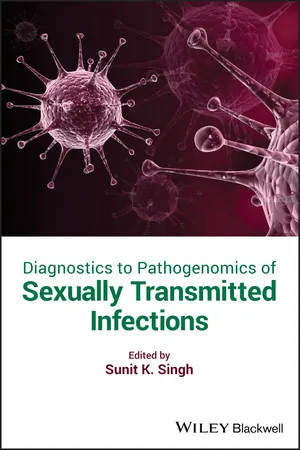
- English
- ePUB (mobile friendly)
- Available on iOS & Android
Diagnostics to Pathogenomics of Sexually Transmitted Infections
About This Book
Comprehensively explores sexually transmitted diseases, from epidemiology, causative pathogens, clinical impact, and immunology, to management strategies utilizing new strategies of genomics and next-generation diagnostic tools
Sexually transmitted infections (STI) are very common worldwide. More than 20 different STIs have been identified, and about 19 million men and women are infected each year in the United States alone. This book looks at the complete picture of common STIs— how they form, evolve, and transmit, as well as how they can be treated and managed with modern techniques, medicines, and tools.
Diagnostics to Pathogenomics of Sexually Transmitted Infections runs the spectrum of discussion ranging from introduction of causative pathogen, their pathogenesis to epidemiology, immunology, to anatomy and physiology of human genitalia and management strategies. The book offers in-depth chapter coverage on effect of probiotics on reproductive health; mucosal immunity in sexually transmitted infections; the role of circumcision in preventing STIs; Human Immunodeficiency Virus (HIV); genital herpes; molluscum contagiosum; genital warts; chlaymydia trachomatis; donovanosis; gonorrhoea; treponematoses; genital mycoplasms; bacterial vaginosis; vulvovaginal candidiasis; chlaymydia; scabies; chancroid, yeast infections; and more.
- Comprehensively compiles most of the major sexually transmitted infections
- Presents updated information on clinical aspects of sexually transmitted infections
- Examines the priorities in pathogenesis of human sexually transmitted infections and discusses new strategies of genomics and next-generation diagnostic tools used for detection of such pathogens
- Explores the future of rapid molecular diagnostic techniques and the challenges posed in the diagnosis of human STIs
- Includes bench to bedside content that will appeal to both basic and clinical researchers
By offering the latest knowledge about recent advances in sexually transmitted infections in an interdisciplinary fashion, Diagnostics to Pathogenomics of Sexually Transmitted Infections is the perfect book for virologists, microbiologists, infectious disease experts, vaccinologists, biomedical researchers, clinicians, pharmacologists, and public health specialists.
Frequently asked questions
Information
1
Mucosal Immunity in Sexually Transmitted Infections
1.1 Introduction
1.2 Innate Immunity in the Genital Tract
1.2.1 Humoral Defense Factors in Female Secretions
| Factor | Female | Male |
| Lactoferrin | 1 μg ml−1 (vaginal fluid) | 1.2 mg ml−1 (semen) |
| 0.1 mg ml−1 (cervical mucus plug) | Identified by IHCa in urethral epithelial cells | |
| Lysozyme | 13 μg ml−1 (vaginal fluid) | Identified by IHC in glands of Littré and intra‐epithelial cells |
| 1 mg ml−1 (cervical mucus plug) | ||
| Peroxidase | Identified in vaginal fluid | |
| Defensins | HD‐5 and HBD‐1 found in cervicovaginal secretions, endocervical and endometrial cells | HD‐5 present in urethral secretions as proHD‐5, activated by proteases |
| SLPIb | Produced in glandular epithelium | Identified by IHC in urethral epithelial cells |
| MBLc | Found in cervicovaginal lavage | 1–25 ng ml−1 (semen) |
Table of contents
- Cover
- Table of Contents
- About the Editor – Prof. Sunit K. Singh
- Preface
- 1 Mucosal Immunity in Sexually Transmitted Infections
- 2 The Role of Circumcision in Preventing Sexually Transmitted Infections
- 3 Effect of Probiotics on Reproductive Health
- 4 Human Immunodeficiency Virus (HIV) Infection
- 5 Genital Herpes
- 6 Molluscum Contagiosum
- 7 Genital Warts
- 8 Chlamydia Trachomatis Urogenital Infections: Epidemiology, Clinical Presentations, and Pathogenesis
- 9 Donovanosis
- 10 Gonorrhea
- 11 Sexually Transmitted Treponematoses
- 12 Genital Mycoplasmas
- 13 Bacterial Vaginosis
- 14 Chancroid
- 15 Vulvovaginal Candidosis
- 16 Tinea Cruris
- 17 Trichomonas Vaginalis
- 18 Scabies
- Index
- End User License Agreement